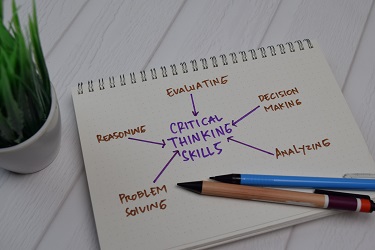
Let’s face it. It’s a fast-paced world. It’s been reported that the average human makes 35,000 choices per day. To apply critical thinking to every decision would be impossible. Instead, your brain is generally operating on automatic mode thinking. You’re still thinking, but you are not diagnosing every choice you’re faced with and the ramifications of those choices. Almost instinctual, you make choices—"What should I have for breakfast?” or “Should I continue reading this post?” —in the blink of an eye. Sometimes, however, we face problems or choices that require us to step out of automatic mode thinking and employ critical thinking to solve a problem or arrive at a decision.
Everyone can benefit from developing and honing their critical thinking skills and applying these skills to solve both professional and personal challenges. Michael Kallet, author of Think Smarter: Critical Thinking to Improve Problem-Solving and Decision-Making Skills, offers a good framework and tools for improving this important skill.
The framework is relatively simple. It involves three components—clarity, conclusions, decisions. In other words, you clearly identify the challenge, create a solution, and act on that solution. The entire process is much more involved and Kallet offers practical guidance and tools throughout his book. For example, as part of the clarity process, he recommends ridding oneself of pre-conceived notions, ideas, and experiences, so you can attack the problem with an open mind. Another tip, if you are working within a group, is to define words to remove any ambiguity. Another important aspect of gaining clarity is asking questions. “Why? Is the most powerful question you can ask during the critical thinking process.” Asking “Why?” helps reinforce the idea you are working on the real issue. Asking “Why?” multiple times can help you get to the root cause of a problem, or it could generate an “I don’t know” response that signals a knowledge gap that, if acquired, could lead to clarity on the issue and a possible solution. Additional questions lead to even greater clarity. Why is this relevant? Why is this important or necessary? There is no limit to the number of questions you can ask in this phase. Some questions such as “If not this, what?” or “What’s Next?” can help be more innovative or lead to anticipatory thinking. Once you have clarity, you move on to the conclusion part of the framework.
Conclusions, according to Kallet, are about coming up with ideas and solutions for your challenge and eventually coming up with a conclusion about what you will do. For this phase, he offers tips for separating fact from observations, how experiences and beliefs can influence critical thinking, and what role assumptions play. Another technique he recommends is triangular thinking—viewing the problem from multiple perspectives. Additional guidance is provided for creating solutions and, once again, questions play a big role.
The last part of the framework is decisions. You’ve clarified the problem and you created a solution. The last step is to act. Decision is a separate component of the framework because the decision to act on a solution might rest with someone else. Kallet delves into the information a decision maker will use to form their decision and how they evaluate risk. Understanding that thought process can only help you become a better problem solver.
Written by Baron Williams, CAE
References:
How Many Decisions Do We Make Each Day?
Think Smarter: Critical Thinking to Improve Problem-Solving and Decision-Making Skills. 2014. John Wiley and Sons, Hoboken, NJ. p. 33.
#2021
#LeadershipDevelopment
#Blog